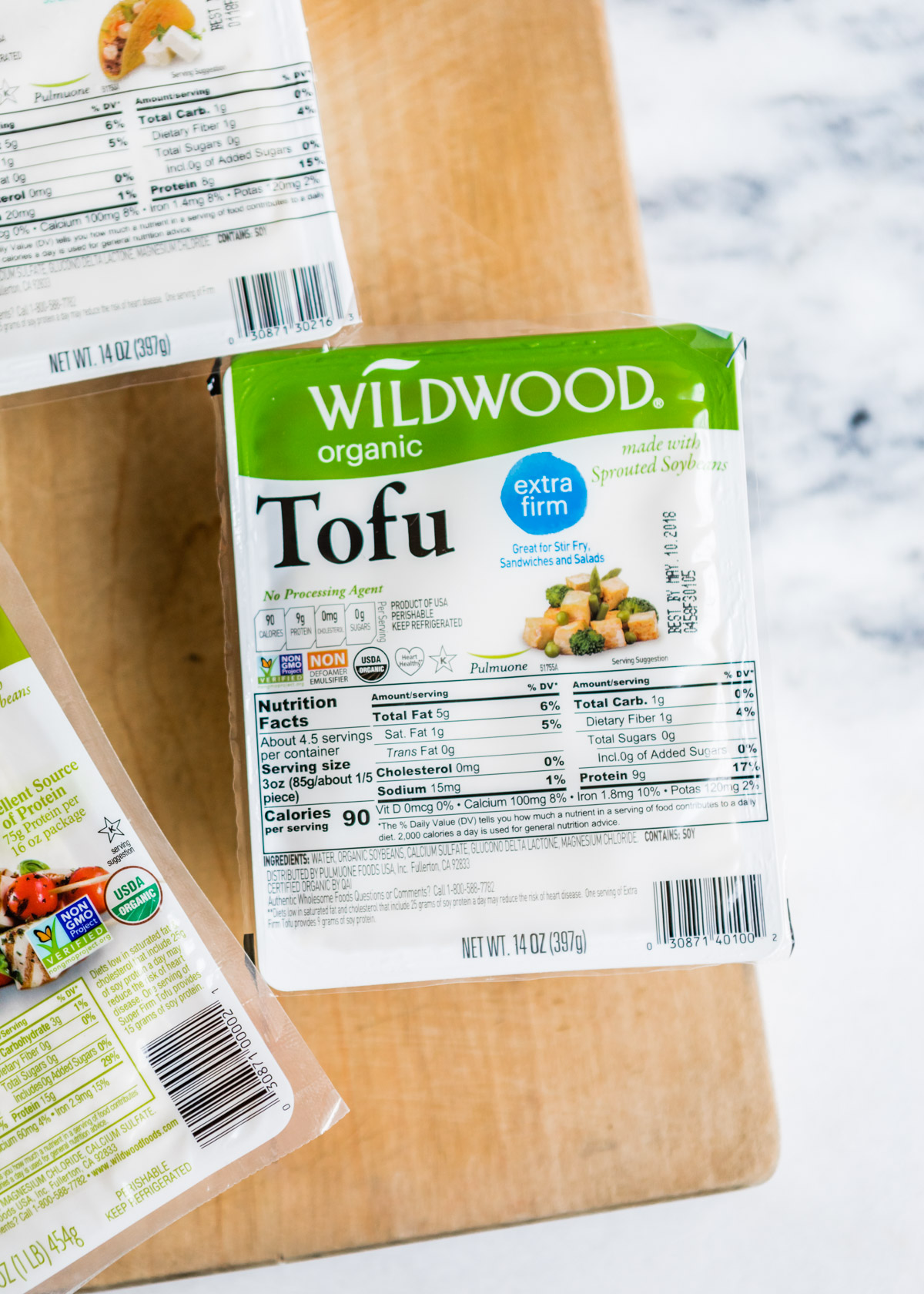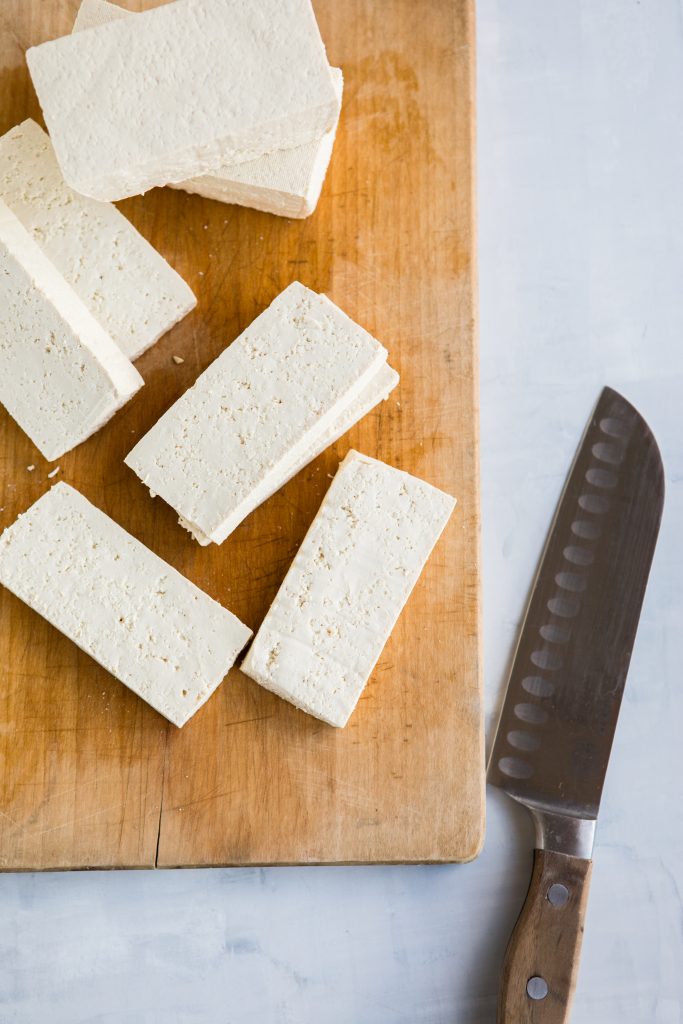Is there any food more polarizing than tofu? It’s used by meat-eaters as a cudgel to prove that vegetarian food is gross; even within the vegetarian community, there are people who think tofu should be avoided at all costs because of GMOs (spoiler: it’s super easy to find GMO-free tofu at almost any grocery store) or because they believe soy is an endocrine disrupter.
This article isn’t about the health aspects of soy. I’m assuming you’re reading this because you’re new to cooking with tofu and you’re wondering: how do I make this bland, white, rectangle of mush actually taste good?

While there are some people who like tofu as-is, I’m not one of them. I think uncooked tofu–or even tofu that’s not cooked to the point of being chewy–is unappetizing. I was about a decade into my vegetarianism before I started eating it. My husband (then boyfriend) would buy it and add it to stir fries and it would disintegrate into little mushy, flavorless blobs that ruined an otherwise delicious bowl of vegetables. Ugh.
Then I tried it in pad Thai at a restaurant and it was different. It was chewy! And full of flavor! Why was this tofu so good? I started eating it more often, researching recipes, experimenting in the kitchen, and figured out the secret to cooking with tofu.
(Which, okay, really wasn’t much of a secret at all. But it’s important to know if you’re new to tofu!)
A Few Words About Tofu Types
Of course, you can’t really write about cooking with tofu without talking about the different types of tofu. You can divide them into two main categories: water-packed refrigerated tofu and shelf-stable silken tofu.
If your beef (har har) with tofu is its mushy texture, it’s probably silken tofu that you’re thinking of. It’s quite soft and doesn’t stand up to cooking very well. Firm silken tofu is nice in miso soup, and silken tofu is also useful for making sauces and even desserts. Most recipes that call for tofu assume you are buying water-packed tofu, not silken!
Like silken tofu, refrigerated tofu also comes in varieties that range from soft to extra firm. (There are also baked and marinated tofus, which are good for adding to salads or using anytime you need a readymade vegetarian protein.) I pretty much always cook with extra firm; occasionally a recipe will call for firm tofu, but I usually still buy extra firm because I find that it has the best texture when cooked.

Tofu Is Best When It’s Pressed
Because when you press tofu, you’re getting all the liquid out so it can soak up any sauces you add to it. Releasing that excess liquid also helps tofu take on a chewier texture.
So how do you press tofu? If you find yourself cooking with tofu often, I highly recommend investing in a tofu press. It’s the easiest and most effective way to get all the water out. Otherwise, layer some towels (paper or cloth) on a cutting board, put your tofu on top of them, then top that with a plate and something to weigh the plate down, like a few cans of beans. (Make sure the weight is evenly distributed or your tofu might end up being smashed on one side!)
Let your tofu sit for 30 minutes, draining or switching out towels when needed. After 30 minutes, you can slice, dice, and start cooking. Sometimes after slicing, I’ll blot the slices with paper towels just to get any extra liquid off, particularly when I’m going to be frying the tofu on the stovetop.
Many people are partial to freezing tofu, letting it thaw, then cooking with it. I like doing this when I’m making a soup with tofu because I find the tofu does a better job soaking up the broth that way, but otherwise I don’t do this unless a recipe specifically calls for that step.
Adding Flavor to Your Tofu
Now that you’ve pressed all the liquid out, you can replace it with a delicious marinade or sauce. If I’m baking or grilling tofu, I always use a marinade; if I’m frying it, I skip the marinade and add sauce later. This helps keep the tofu from getting mushy or falling apart while cooking.
Oil-based marinades won’t soak into tofu; a simple mixture of tamari, minced garlic, and maple syrup is one of my favorites. For a bacon-y flavor, try adding liquid smoke or smoked paprika.
Baking tofu basted in barbecue sauce is one of my go-to easy proteins for weeknight dinners. I also love using jarred Indian simmer sauces with tofu and serving it with cauliflower rice.
How to Cook Your Tofu
My favorite way to cook tofu is in a sizzling hot frying pan with plenty of oil. Make sure your tofu is super dry, then cook it over medium-high on all sides until they’re lightly browned and crisp. The resulting crispy tofu is amazing for dipping into homemade peanut sauce with some steamed broccoli, but you can also stir fry some veggies and toss the tofu back into the frying pan with the sauce once the veggies are done. (Incidentally, skipping the whole frying-the-tofu-separately step is why my husband’s early attempts at tofu stir fries were so bad.)
Baking tofu works best at a temperature of 400ºF; the longer you leave the tofu in the oven, the chewier it will be, so I usually prefer baking for at least 40 minutes, taking the tofu out every 15-20 minutes or so to flip and baste with leftover marinade or sauce.

Tofu Recipes You Should Try
If you’re still getting the hang of cooking with tofu, it’s good to start with a recipe. Here are some of my favorites:
Beer-Battered Tofu Tacos
Ginger Peanut Tofu Wraps
Miso-Almond Power Salad with Baked Tofu
Whiskey Garlic Tofu
Turmeric Tofu Scramble